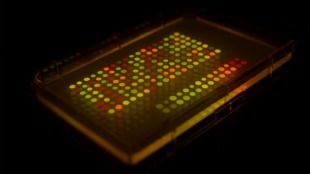 Invisible ink penFLICKR, SPIKE55151
Invisible ink penFLICKR, SPIKE55151
Gene expression has become the new invisible ink. Researchers report in this week's Proceedings of the National Academy of Sciences that they have developed a color-coded system of encryption that uses fluorescent proteins to deliver information.
“The idea is fairly obvious of trying to take the colors and using them to hide a code. I'm surprised no one has done it before actually,” said Marc Zimmer, a fluorescent protein researcher at Connecticut College, who was not involved in this study.
The researchers engineered seven strains of E. coli to each express a different color fluorescent protein, and assigned unique color combinations to represent various letters and numbers. They then arranged the bacteria in neat rows of colonies on a multiwell agar plate, intended to be read from left to right like normal English text.
Two adjacent bacterial colonies expressing yellow fluorescent protein denotes the...

“It's like what you did as a kid with scrambling up the alphabet and numbers and sending a message,” said David Walt, an author of the study and a professor at Tufts University. "We've just done it in a slightly more sophisticated way."
The team also added in a few extra security measures, such as a requirement for the correct growth medium. Several strains of bacteria, engineered to have resistance to different antibiotics, were placed in each well on the source plate. Those bacteria were then transferred to a new plate and grown in media containing a particular antibiotic, thereby selecting for strains of bacteria resistant to that drug. If the growth medium contained the antibiotic kanamycin, for example, bacteria that grew would reveal a ciphertext (the coded message) that translated to “you have used the wrong cipher and the message is gibberish.” If instead those same bacteria were grown with the antibiotic ampicillin in the medium, the correct message would appear.
The study was funded by the Defense Advanced Research Projects Agency, a military organization. Walt told The Scientist that the agency was looking for a way to send messages without any electronics.
Zimmer said fluorescent proteins are reliable to work with and come in a wide variety of colors, but it's hard to envision spies in the field using a molecular biology set-up to exchange messages.
Ethan Heilman, a software engineer and a cryptography researcher, said the study is heading in the right direction, but because the system uses conventional molecular biology techniques, it's fairly open to attack. In particular, hackers could sequence the bacterial genes to find out its code. “The first thing a hacker would want to do is take apart your machinery, so you want to make it difficult,” Heilman told The Scientist.
Walt said he's exploring different ways to make the system more complicated, such as adding timed layers of protein expression, in which the color changes over time reveal the secret note.
Though the method might not be ready for the CIA, it's providing inspiration. “I've always wanted to write a crime thriller with green fluorescent protein in it in some way, and this would be the way to do it,” Zimmer told The Scientist.
M.A. Palacios, et al., “InfoBiology by printed arrays of microorganism colonies for timed and on-demand release of messages,” PNAS, DOI: 10.1073/pnas.1109554108, 2011.




